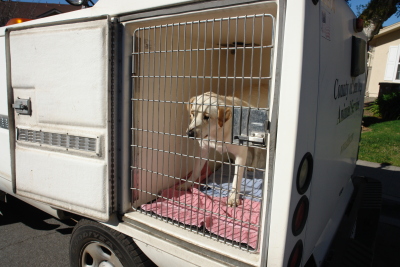Animal Control Officers Embrace Portable Computers
/
The duties are surprisingly diverse, but they have one thing in common: they happen in the field, not behind a desk. But until recently, the officers had to return to the County shelter each day, sometimes for hours before going off duty, to enter their reports into a computer.
Now, most County animal control officers have a portable laptop that frees them to work in the field longer each day handling more calls. The use of technology is part of a Countywide focus: Government without Walls—or GWOW—which encourages departments, when it makes sense, to adopt technology and non-traditional schedules and work environments to help staff be more mobile, efficient and effective. Currently a variety of County inspectors, Public Health nurses and Public Guardian investigators are also part of the movement, using computers, wireless internet and other technology to better serve the public in the field.
“I’m on cloud nine with the fact that I have the computer right now,” said Animal Control Officer Shalimar Oliver, who recently demonstrated how she used her compact Panasonic Toughbook in the center console of her kennel truck.
Working without walls
During one of Oliver’s January shifts, a woman called Animal Services complaining that someone was leaving his dog in a truck all day at a Mira Mesa business park. The dispatcher who answered the phone entered a description and address into the computer system; Oliver could see the information on her screen.
Previously, the dispatcher would have relayed the call over the radio. The officer would have had to scribble the details on a notepad, asking the dispatcher to repeat anything she’d missed.
This practice was sometimes inaccurate and always time consuming. The use of laptops has also freed the single dispatcher who answers the Animal Services patrol line for the whole region. When she is on the radio with officers, the public waits on hold. Now there are fewer hang ups and therefore more animals getting help.
And officers no longer must wait for the busy dispatcher to contact them on the radio to help an animal. Now officers can see a call on the computer and go. The time saved could mean the difference between life and death if, for example, the call is for an animal that’s been hit by a car.
At the Mira Mesa business park, Oliver pulled her white truck alongside the pickup truck. No animal inside this time.
So Oliver parked for a couple minutes and noted the case’s conclusion in her computer. She radioed the dispatcher too, saying little more than, “10-98,” meaning this assignment was done.
“We used to have to tell the dispatcher what the outcome of the call was,” said Oliver. The dispatcher then entered the details into her computer. If the case was complicated, this could be a long conversation, again tying up the dispatcher and officer.
After finishing the quick Mira Mesa case, Oliver had a rare lull with no assigned call. So she looked at her computer screen, which showed what other animal control officers were doing and whether they had pending assignments stacked up. Indeed, a busy officer had a waiting assignment to check on a report of cats with open sores in a Bay Park neighborhood.
Oliver was on it. These days, if a fellow officer is busy, Oliver uses the computer interface to easily transfer a waiting call to her own assignment list. Again, animals and the public get help faster.
Early success
Animal Services Lt. Dan DeSousa said all officers at the shelters in Bonita and San Diego have the laptops, and staff in North County will get them soon. He said officers, like Oliver, are reporting many benefits from the technology, and the program shows that in some cases, it just doesn’t make sense to work within walls.
“The thing is, why not?” DeSousa said. “If you can do this work better out in the field, why do you have to come back to the office?”
Read more about how GWOW benefits County animal control officers:
Customer Service and Animal Welfare: These days, when Oliver comes across a stray dog with a collar or microchip, she can look up the pet’s license information in the field, and maybe reunite the animal with an owner immediately. That keeps the dog out of the crowded shelter.
Investigations: Oliver and other County animal control officers investigate criminal animal cruelty or neglect cases. After a witness interview, Oliver now immediately makes a detailed account of the conversation in her vehicle’s computer. This timely record helps win prosecutions.
Officer Safety: Recently, Oliver’s fellow officer radioed for help with an aggressive dog. Oliver said she used her computer to see her colleague’s location, and the nature of the call. Before the busy dispatcher could send anyone, Oliver was on her way. Officers can also use the computer to research the history on any address to see if there have been problems with animals or owners there in the past.
Enforcement: Oliver said she recently had to cite a woman who’d let her dog run loose and bite someone. But the woman was avoiding Oliver, so the officer used her computer to do some internet research. Facebook revealed where the woman worked, and Oliver cited her there.
Public Presence: When people see an animal control truck, they’re more apt to follow laws, such as keeping dogs on leashes. So keeping officers in the field, even if they’re parked and writing reports, increases public safety.
